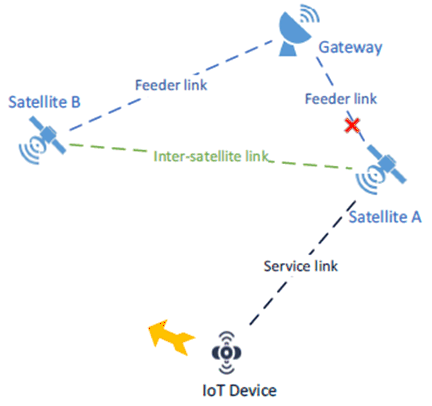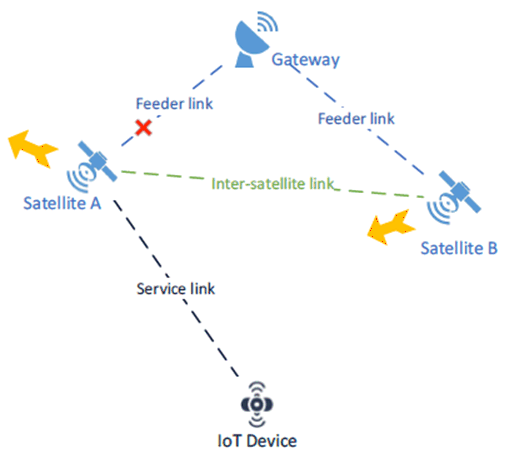Content for TR 22.865 Word version: 19.2.0
5.3 Use case on store and forward - Inter-satellite
5.3.1 Description
5.3.2 Pre-conditions
5.3.3 Service Flows
5.3.4 Post-conditions
5.3.5 Existing features partly or fully covering the use case functionality
5.3.6 Potential New Requirements needed to support the use case
...
...
5.3 Use case on store and forward - Inter-satellite p. 13
5.3.1 Description p. 13
To expand the market of delay-tolerant IoT devices, store and forward operations are necessary to be developed to sustain the user plane data during the feeder link disconnection between the satellite and the terrestrial gateway. Based on the earlier studies [3] [4], there are many use cases can be further improved with such mechanisms.
Regardless of scenarios describing a relative static location relationship of a IoT device, a satellite without an available terrestrial gateway (as shown in clause 5.1 and 5.2), the serving satellite may change to another one during the time when the feeder link is unavailable. And such unavailable state of feeder link may be caused by the temporary reconstruction or update of terrestrial gateway.
As shown in Figure 5.3.1-1, a mobile IoT device may move from the coverage of one satellite to the other (e.g. containers tracing and tracking), or as shown in Figure 5.3.1-2, a NGSO satellite may fly away and the other one will come and turn to serving a static IoT device. Under such circumstances, the serving satellite may forward the stored user plane date to the next serving satellite through Inter-Satellite Links, and the next serving satellite may help forward the data to the gateway.
Meanwhile, if the feeder link of the next satellite is also unavailable, it will continue the store operation until the recovery of its feeder link. In this way, for every single IoT device, there will be only one satellite for its data storage in the overall satellite system. And the mobile operators will be easier to manage and maintain the data rather than dealing with the separate data which is belong to one device but among different satellites.
Significantly, during the period that the feeder link is unavailable, the serving satellite only stores or forwards (Inter-satellite) the data received from an IoT device which is already able to send data to the application server through the mobile network with satellite access. Because of the disconnection separates the two parts of the mobile network temporarily, the part in the serving satellite will not be able to fulfill common communication procedures and it will refuse any access from an unregistered device.
Furthermore, considering the limited data storage in satellite and the large amount of IoT devices, a maximum storage for each IoT device should be pre-configured based on the application data characteristics, user subscriptions and overall performance of satellite communication system.

Figure 5.3.1-1: Serving satellite change during the feeder link disconnection - IoT device moving
(⇒ copy of original 3GPP image)
(⇒ copy of original 3GPP image)

Figure 5.3.1-2: Serving satellite change during the feeder link disconnection - satellite moving
(⇒ copy of original 3GPP image)
(⇒ copy of original 3GPP image)
5.3.2 Pre-conditions p. 15
A delay-tolerant device has a subscription with the terrestrial operator TerrA, and it is tagged on one container for tracing and tracking.
TerrA has agreement with the satellite operator SatA for satellite access.
SatA maintains multiple serving satellites for the satellite access of TerrA's subscribers all over the world, including Adam and Bob.
5.3.3 Service Flows p. 15
- The container will be shipped from the Harbour A to the Harbour B across the Pacific. After the cargo ship leaves the Harbour A, the device can send some packets through the satellite access during the shipping time.
- Due to some reasons, the feeder link between the serving satellite Adam and terrestrial gateway is interrupted temporarily or couldn't be used for a time.
- Based on the configuration of store and forward operations, Adam will go on to receive the packets from the device, and store these packets until the feeder link recovers.
- However, during the period of feeder link is unavailable, the cargo ship approaches the border of coverage of Adam and will head to the coverage of another satellite Bob. So, based on the movement of the cargo ship, the serving satellite will change.
- During the period of the change, Adam sends the stored packets to Bob through the inter-satellite link and Bob will forwards the packets to the gateway if its feeder link is available.
- Particularly, Bob will continue storing the packets if its feeder link is also unavailable.
5.3.4 Post-conditions p. 15
Those packets will be finally sent to the application server by the network behind the gateway, e.g. transportation network, core network, internet. And the application will parse some information from the packets.
5.3.5 Existing features partly or fully covering the use case functionality p. 15
Clause 6.3.2.3 of TS 22.261 on satellite access includes the following requirements:
The 5G system shall be able to provide services using satellite access.
The 5G system with satellite access shall be able to support low power MIoT type of communications.
However, it is not sufficient in regards of S&F operation especially for the delivery of delay-tolerant/non-real-time IoT NTN services with NGSO satellites.
5.3.6 Potential New Requirements needed to support the use case p. 15
[PR.5.3.6-001]
Subject to operator's policies, a 5G system with satellite access shall be able to store data received from authorized UEs using delay-tolerant communication service while the feeder link is unavailable.
[PR.5.3.6-002]
Subject to operator's policies, a 5G system with satellite access shall be able to support forwarding of the stored data received from authorized UEs using delay-tolerant communication service from one satellite to another satellite through Inter-Satellite Links while preserving integrity protection, confidentiality and security of the data.
[PR.5.3.6-003]
Subject to operator's policies, a 5G system with satellite access shall be able to define the maximum amount of data storage per satellite per authorized UEs using delay-tolerant communication service.
[PR.5.3.6-004]
The 5G system with satellite access shall be able to authorize the communication of a UE when the satellite access is operating in store and forward mode.